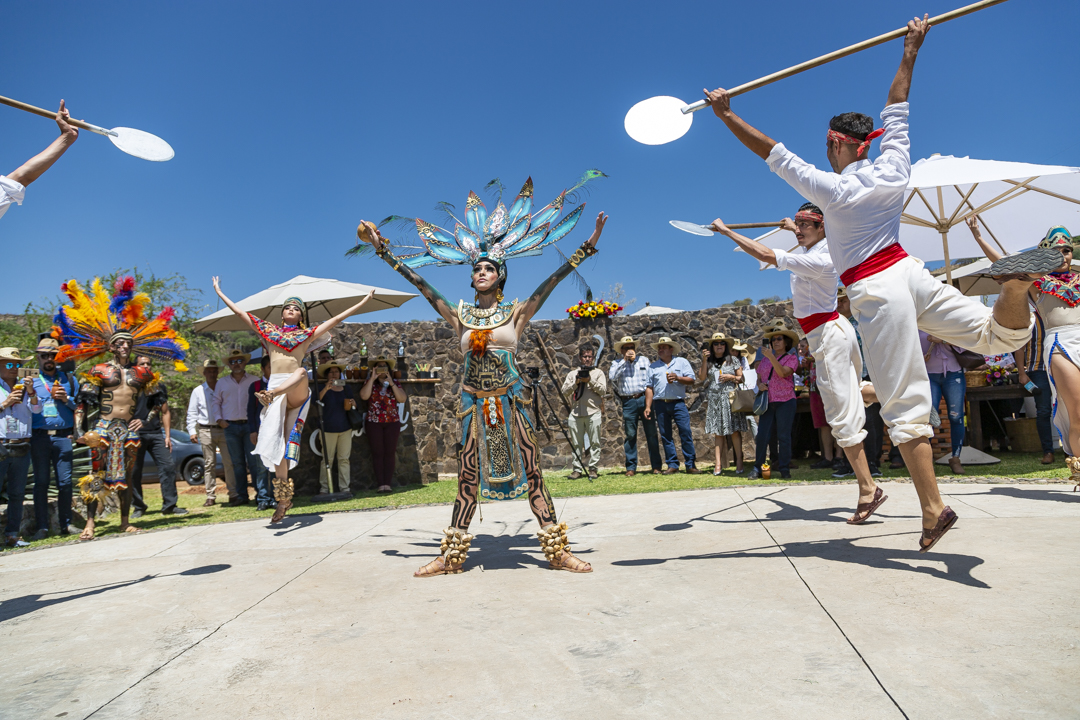
Tequila in the prehispanic era
The Mezcalli
In this era, the tequila drink as such did not exist; it was known as mezcalli or mezcal, which in Nahuatl means cooked maguey. This cooked maguey fermented naturally, given the particularities of the plant itself. Being fermented, those who tasted it showed a slight dizziness, which is why the indigenous people of that time thought that this was a drink sent by the gods for festive reasons.
The agave in the life of the indigenous
The agave as such in its different species was very important in the economic life of the indigenous people, it was used as:
- Exchange currency
- For construction, for tiles
- For yarns, clothes
- For ropes/ropes
- I enter other uses more...
Historical documents about this drink
The first document that was found that spoke about this topic was from 1536, by Fray Toribio de Benavente. He wrote that among the customs of the peoples of New Spain, he found that these people, these indigenous people, obtained a slightly fermented and vinegary drink, and in this way, in order to identify it during the same period, it was called mezcal wine.
Was this fermented plant a plant that went through a cooking process?
It could be cooked or not. Pulque, for example, does not come from a cooked agave; it is a drink that was extracted from the pineapple of the agave, which was thick and fermented and is fermented, and it was a kind of beer, so to speak, without passing for distillation as such. When drinking this product, people felt a little dizzy, but when cooking it, when a specific time passed, that sugar and all the starches and everything that caused that natural fermentation of the same plant also caused that type of alcohol to light on the plant. So, it was fresh in some parts, as it could be cooked. In other words, before cooking, he gave us pulque, and pulque is a freshly fermented drink, without cooking, from an agave.
The cooking was already done more as a sweetener and as a drink, but not fermented; it was cooked. And eventually, when that drink went through a period of rest, it obviously fermented; let's say it spoiled. So people cooked it, used it, and what was left, they tasted it again for a few days, and oh!… well, then it was like a kind of vinegar. That is why Fray Toribio said that they drank a kind of vinegary drink. It wasn't really vinegary, well, it was vinegary, but really, it was the fermentation of a drink.
The distillate of the drink: Convergence of 2 versions
Actually, the two versions of the distillate of the drink converge:
- The pre-Hispanic indigenous groups.
- With the arrival of the Spanish, the Nueva Galicia.
Tequila and the prehispanic era
Quite a few notes and exercises talk about certain traditional and ancestral distillations from the East before the conquest.
Along the course of Colima and latitudes close to this site, vessels have been found that resemble those used in oriental distillation. That is why it is believed that long before the Spanish conquest, a distillation similar to the oriental one was already being made.
The oriental distillation was somewhat different from the Arab stills. The Orientals made a kind of vessel that they heated from below with firewood and had a kind of plate on top... this condensation of liquid passed through a small tube, and that small tube eventually produced a highly graduated distilled beverage.
This is what leads us to wonder if the indigenous people in Mexico were already beginning to do a kind of distillation before the conquest; wonder if the easterners arrived in these lands before the Spaniards and left these practices as their heritage.
However, there is nothing official about it. Several scholars have found these remains of vessels, more like cocopachas. Some brands of mezcal continue to distill in these cocopachas. The cooking of mezcal, unlike tequila, can be done in different ways. One of them is made precisely with a kind of giant vessel: below, it is cooked with fire, and above, when the liquid begins to smoke, it condenses, and this condensation leads to what we currently call "ancestral mezcal".
The arrival of the Spanish
Let us remember that the Spanish inherited the theme of distillation from the Arabs and applied it to their wines, rums, brandies, etc. When they came to Mexico, they brought their reserves of wines and spirits, but over time, they obviously ran out. It was then that they began to look for a way to distill right here in Mexico, and when they began to intervene in this famous mezcal wine in order to produce a distillate from the agave.
Official Documents and Legends of Tequila
So let's say these were the first attempts or the beginnings of what we call tequila today. The State Library and other official INAH (National Institute of Anthropology and History) documents recently found that a drink called mezcal wine was already being produced long before the permit was granted to a Creole from the region in 1785. In 1785 Carlos II granted permission for the drink to be made, but information has been found that indicates that even before this permit, some people produced the drink.
Now, on the one hand, we have the official historical documents, as well as theories elaborated based on archaeological remains found in the area, and on the other hand, the legends about the origins of the drink that revolve around Mexican mythology, to which Aztec deities.
Let's review these legends.
Prehispanic legends of Tequila
There are several legends, but the most famous is that of the Goddess Mayahuel.
This legend tells that Mayahuel was a goddess who was in a fight to die with her grandmother, the goddess Tzitzimín, and she decided to ask Xochitiotzin for support to go down to earth to hide from this evil grandmother. Tzitzimitzin, realizing that Mayahuel is escaping from her, decides to go looking for her.
Xochitiotzin then hides Mayahuel in the form of a tree, and this tree ends up falling in love with Quetzalcóatl, the most significant deity of the Aztecs (the agave was so crucial to the indigenous people, who put it on the level of an affair with Quetzalcoatl). Eventually, both decide to hide from Tziztimitzin by taking the form of an oak and a holm oak. This oak and this oak, as they grew, intertwined their branches as if holding hands and being together. When Tzintzimitzin finds out that his granddaughter has hidden, taking the form of a tree, he decides to send lightning.
This is where the legend gets a bit confused. It is erroneously said that lightning struck an agave, but it is not. The lightning that fell in the Legend of Mayahuel falls on the tree, and the tree catches fire, burns, and dies. Then Quetzalcoatl, as a way of honoring his beloved, decides to replant these remains of the tree so that they can be reborn, but they are reborn in the form of agave.
That is why the goddess Mayahuel is known as the Goddess of Fertility. People say that she is the Goddess of Agave, but she is actually the Goddess of Fertility.
It is said that since then, Mayahuel has always struggled to be present, just like the agave. The agave can face tremendous environmental adversity, and it can face freezing weather, too hot weather, exorbitant rainfall, or drought, and yet it will always be reborn. In fact, as part of the tequila production process, we stress the plant.
What is stressing the plant?
First, we cut the shoot and then let it dry; this stresses the plant. Later, when we plant it, the plant absorbs all the minerals and proteins from the earth. That is why when the agave is planted, all the shoots are very damaged... Well, they really dried up.
The agave, a robust and versatile plant
So the agave is a plant with enormous versatility but also a lot of endurance. And from the legend follows that no matter what you do, the agave will always flourish.
Even if you cut the agave, it grows a shoot. You remove the offspring, and another one comes out... So that's where the legend of fertility comes from.
.png?width=50&height=50&name=10.CS-Redondo%20(1).png)
